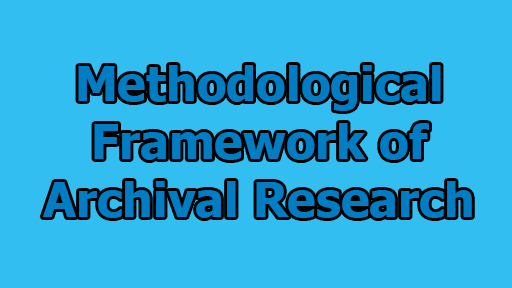Methodological Framework of Archival Research:
Archival research is a methodological framework used in social sciences, humanities, and various other disciplines to gather and analyze primary sources stored in archives. It involves systematic investigation, interpretation, and analysis of historical documents, records, manuscripts, and other materials preserved in repositories, libraries, or specialized collections. This methodological framework serves as a crucial tool for scholars, historians, sociologists, anthropologists, and researchers seeking to explore and understand the past, society, culture, and human behavior. In this article, we will explore the methodological framework of archival research involves various steps and considerations:
1. Identifying Research Objectives: Before embarking on archival research, it’s crucial to clearly define the research objectives. This involves:
- Refining Research Questions: Formulate specific and focused research questions that guide the direction of the study. For instance, in historical research, questions might revolve around understanding social movements, political changes, or cultural shifts during a particular period.
- Establishing Goals: Define the overarching goals of the research. Determine whether the aim is to challenge existing historical narratives, provide a new perspective, or fill gaps in current knowledge.
- Setting Scope and Boundaries: Clearly delineate the boundaries and scope of the research. Decide on the time frame, geographical area, or specific aspects of the topic under investigation.
- Considering Significance: Assess the significance and relevance of the research objectives. Understand how the findings might contribute to existing scholarship or address contemporary societal concerns.
- Adapting Objectives: Remain open to refining or adapting the research objectives based on the findings and discoveries made during the archival exploration. Flexibility in approach can lead to new insights.
2. Locating Relevant Archives: Finding suitable archives is fundamental to successful archival research. This involves several steps:
- Researching Archive Holdings: Utilize library catalogs, online databases, archival directories, and consultation with librarians or archivists to identify repositories holding relevant materials. Explore specialized collections or niche archives that might contain unique or overlooked sources.
- Understanding Access Policies: Review access policies and procedures of different archives. Some repositories might have specific visiting hours, access restrictions, or requirements such as appointments, letters of introduction, or permissions for accessing sensitive materials.
- Considering Accessibility: Assess the practicality of accessing archives. Consider factors like location, available resources, travel feasibility, and any associated costs or logistical challenges.
- Prioritizing Resources: Evaluate the comprehensiveness and relevance of archival holdings to prioritize visits or requests for materials. Plan visits or inquiries strategically to optimize research time.
- Network and Collaborate: Engage with scholars, experts, or colleagues familiar with archival research in the field. Networking can offer insights into lesser-known archives or alternative sources.
3. Access and Permissions: Once potential archives are identified, navigating access protocols is crucial:
- Contacting Archival Staff: Communicate with the archivists or librarians in advance. Inquire about access procedures, necessary identifications, and any prerequisites for accessing specific collections.
- Understanding Restrictions: Be aware of any restrictions on certain materials, such as confidential documents, fragile items, or copyrighted materials. Comprehend the limitations imposed by the archive and respect their policies.
- Obtaining Permissions: If required, obtain necessary permissions or approvals to access restricted materials. This might involve submitting research proposals or complying with ethical guidelines.
- Maintaining Professionalism: Adhere to the rules and regulations of the archive. Respect the materials, handling them with care, and following any preservation guidelines provided by the staff.
- Digital Access: In cases where physical access is challenging, explore digital access options. Some archives offer online databases or digitized collections that can be accessed remotely.
4. Primary Source Selection: Selecting the most relevant primary sources is a critical step:
- Aligning Sources with Objectives: Choose primary sources that directly align with the research objectives and questions. Prioritize materials that offer insights into the chosen topic or period.
- Diverse Sources: Aim for a diverse range of sources. Combining different types of documents like letters, official records, newspapers, photographs, and personal diaries can provide a comprehensive understanding.
- Assessing Authenticity and Credibility: Evaluate the authenticity and credibility of the sources. Consider factors such as the author’s bias, context, and the reliability of the information presented.
- Considering Context: Understand the historical and cultural context in which the sources were created. This contextual understanding is essential for accurate interpretation and analysis.
- Sampling Strategies: Employ sampling strategies if dealing with extensive archives. Sampling helps manage the volume of materials, especially when the archive contains an overwhelming amount of information.
5. Ethical Considerations: Maintaining ethical standards is paramount in archival research:
- Respecting Privacy and Confidentiality: Safeguard the privacy of individuals mentioned in the documents. Respect confidentiality agreements and be cautious when dealing with sensitive or personal information.
- Complying with Copyright: Adhere to copyright laws and intellectual property rights. Seek permission when reproducing, quoting, or using copyrighted materials beyond fair use.
- Cultural Sensitivity: Approach materials with cultural sensitivity, acknowledging potential cultural differences and interpretations. Avoid imposing contemporary biases or judgments on historical contexts.
- Transparency in Research: Maintain transparency in the research process. Clearly cite and acknowledge sources to give due credit to archival materials and contribute to academic integrity.
- Long-Term Preservation: Consider the long-term preservation of materials used. Handle documents carefully to avoid damage and support the archival institution’s preservation efforts.
6. Data Collection and Documentation: Once access to relevant archives and materials is secured, the meticulous process of data collection and documentation begins:
- Systematic Cataloging: Develop a systematic approach to cataloging the collected materials. Organize the documents according to themes, dates, authors, or any other relevant categories that align with the research objectives.
- Detailed Note-Taking: Take comprehensive notes while examining the materials. Record important details such as dates, locations, names of individuals, key events, and any observations or interpretations that might aid in analysis.
- Transcriptions and Copies: Create transcriptions or copies of documents if allowed by the archive. Digital scans or photographs of the materials can facilitate further examination and analysis without constantly handling the original documents.
- Maintaining Source References: Ensure accurate referencing of sources. Note down archival information like collection names, box numbers, folder titles, and archival codes to facilitate proper citation and future retrieval.
- Data Verification: Verify the accuracy of transcriptions or copies against the original documents. Any discrepancies or uncertainties should be noted and cross-checked during the analysis phase.
7. Critical Analysis and Interpretation: Engaging in critical analysis and interpretation is at the core of archival research:
- Contextual Understanding: Contextualize the collected materials within their historical, social, and cultural contexts. Understanding the circumstances in which the documents were created is crucial for accurate interpretation.
- Historiographical Approach: Consider existing historiography and scholarly debates related to the research topic. Evaluate how the findings from the archival materials contribute to, challenge, or reinforce current historical understandings.
- Analytical Framework: Apply suitable analytical frameworks or theories to interpret the materials. This might involve qualitative analysis, content analysis, or thematic coding to extract meaningful patterns or themes.
- Identifying Patterns and Trends: Look for recurring themes, patterns, or trends across various documents. Identify connections or relationships among different sources to construct a cohesive narrative.
- Acknowledging Biases: Remain aware of potential biases inherent in the sources. Recognize the perspectives and limitations of the authors or creators of the documents, considering their biases or motivations.
8. Cross-Referencing and Verification: The process of cross-referencing and verification ensures accuracy and reliability:
- Comparative Analysis: Cross-reference information across multiple sources within and outside the archive. Verify facts, dates, events, or claims by corroborating evidence from different documents or secondary sources.
- Fact-Checking and Validation: Verify the authenticity of information presented in the archival materials. Scrutinize conflicting accounts or discrepancies, striving for accuracy in the analysis.
- Triangulation of Data: Employ triangulation by comparing findings from the archival sources with other primary or secondary sources. Consistency among multiple sources strengthens the credibility of the research.
- Consulting Subject Matter Experts: Engage with experts or scholars in the field to validate interpretations or seek guidance on ambiguous or complex historical contexts mentioned in the materials.
- Documenting Limitations: Document any limitations or uncertainties arising from conflicting information or gaps in the archival records. Acknowledging these limitations adds transparency to the research process.
9. Organization and Cataloging: Efficient organization and cataloging of collected data support effective analysis and future reference:
- Database Management: Maintain a structured database or catalog system to organize the collected materials. Use software or tools designed for archival management to categorize, index, and retrieve information efficiently.
- Metadata Creation: Develop detailed metadata for each document. Include descriptive information such as title, author, date, source, keywords, and any relevant contextual details to facilitate easy retrieval.
- Thematic Grouping: Group related documents thematically or chronologically within the database. This allows for a coherent organization that aids in better understanding and analysis of interconnected materials.
- Indexing and Searchability: Create an indexing system that enables easy searchability within the database. Use standardized terms, keywords, or tags to facilitate quick access to specific documents or themes.
- Regular Updating: Continuously update and maintain the database or catalog as new materials are discovered or as further analysis reveals additional insights.
10. Drawing Conclusions: The final steps involve drawing conclusions based on the analyzed materials:
- Synthesizing Findings: Synthesize the analysis and interpretations of the archival materials. Summarize key findings, trends, or significant insights that address the research objectives.
- Formulating Hypotheses or Arguments: Develop hypotheses or arguments supported by the evidence gathered from the archival research. These conclusions should be logically derived from the analyzed materials.
- Addressing Research Questions: Ensure that the conclusions directly address the initial research questions or objectives set at the beginning of the study.
- Critical Reflection: Reflect on the implications of the findings. Consider how the conclusions contribute to broader understandings in the field and suggest avenues for further research or exploration.
- Presentation of Findings: Present the conclusions in a structured manner within research papers, articles, or reports. Clearly articulate the significance of the findings and their implications for the field of study.
11. Writing and Reporting: Once conclusions are drawn, it’s essential to effectively communicate the findings:
- Structured Presentation: Structure the research findings into a coherent narrative. Follow academic conventions, organizing the paper or report logically, with clear sections such as introduction, methodology, findings, analysis, and conclusion.
- Clarity and Precision: Write in a clear, concise manner, using precise language to convey the research process, interpretations, and conclusions. Ensure that the argumentation is well-supported by evidence from the archival materials.
- Citation and Referencing: Accurately cite all sources used in the research, adhering to the required citation style. Provide proper references for archival documents, acknowledging their archival location and identification details.
- Peer Review and Feedback: Submit the research for peer review or seek feedback from colleagues or mentors. Incorporate constructive criticism and suggestions to enhance the quality and rigor of the research.
12. Peer Review and Validation: Submitting the research for peer review is crucial for ensuring its credibility:
- Submission to Journals or Conferences: Submit the research paper or findings to academic journals, conferences, or scholarly platforms for peer review. This step helps validate the research’s credibility and scholarly contribution.
- Incorporating Feedback: Consider the feedback received from peer reviewers. Revise the research paper based on their comments, addressing any concerns or suggestions to improve the quality of the work.
- Validation of Methodology: Peer review validates the robustness of the archival research methodology employed, ensuring that it meets scholarly standards and contributes meaningfully to the field.
13. Preservation and Archiving: Ensuring the preservation of collected materials and contributing to archival repositories:
- Contributing New Findings: Consider contributing copies of newly discovered documents or materials to relevant archives. Sharing findings ensures their preservation and accessibility for future researchers.
- Supporting Preservation Efforts: Follow preservation guidelines provided by archival staff when handling materials. Respect archival protocols and contribute to the preservation efforts by maintaining the integrity of the documents.
- Digital Archiving: If feasible, consider digitizing materials or collaborating with archives to digitize and make collections accessible online. Digital archiving enhances the longevity and accessibility of historical materials.
14. Reflection and Future Directions: Reflection on the research process and considerations for future studies:
- Assessing Limitations: Reflect on the limitations encountered during the research process. Acknowledge any constraints, biases, or gaps in the archival materials that might have impacted the research outcomes.
- Suggestions for Future Research: Identify areas that require further investigation or exploration based on the findings. Propose future research directions or questions that emerge from the archival research, contributing to ongoing scholarly discourse.
- Personal Learning and Growth: Reflect on personal insights gained through the research process. Consider how the experience of conducting archival research has contributed to professional growth and understanding of the field.
In conclusion, archival research methodology requires meticulous attention to detail, patience, and expertise in historical analysis. It enables researchers to reconstruct narratives, understand societal changes, and contribute valuable insights to academic knowledge. Additionally, technological advancements in digitization and online access to archives have expanded the scope and ease of conducting archival research, making historical materials more accessible to a wider audience.
References:
- Cook, T. (2013). Evidence, Memory, Identity, and Community: Four Shifting Archival Paradigms. Archival Science, 13(2-3), 95-120.
- Cox, R. J., & Wallace, D. (2015). Archival Fieldwork: A Practical Guide for Historians. University of Virginia Press.
- Duranti, L., & Franks, P. (Eds.). (2016). Research in the Archival Multiverse. Monash University Publishing.
- Hedstrom, M., & King, E. (Eds.). (2003). Archival Research and Education: Selected Papers from the 2003 AERI Conference. The Graduate School of Library and Information Science, University of California, Los Angeles.
- Ketelaar, E. (Ed.). (2017). The Future of Archives and Recordkeeping: A Reader. Routledge.
- McKemmish, S., et al. (Eds.). (2016). Archival Science and Postmodernism: New Formulations for Old Concepts. Springer.
- Millar, L. (2015). Archives: Principles and practices. Facet Publishing.
- Pearce-Moses, R. (Ed.). (2005). A Glossary of Archival and Records Terminology. Society of American Archivists.
- Shepherd, E. (2017). Documentary Heritage and the Digital Humanities. Facet Publishing.
- Shepherd, E. (2018). Archival Research: A Guide for Students. Manchester University Press.
- Terry Cook. (1997). What Is Past Is Prologue: A History of Archival Ideas since 1898, and the Future Paradigm Shift. Archivaria, 43, 17-63.
- Yakel, E. (Ed.). (2011). Archival Science: International Perspectives in the Development of the Discipline. Springer.
- Upward, F., & McKemmish, S. (Eds.). (2017). The Future of Archives and Recordkeeping: A Reader. Routledge.

Assistant Teacher at Zinzira Pir Mohammad Pilot School and College










